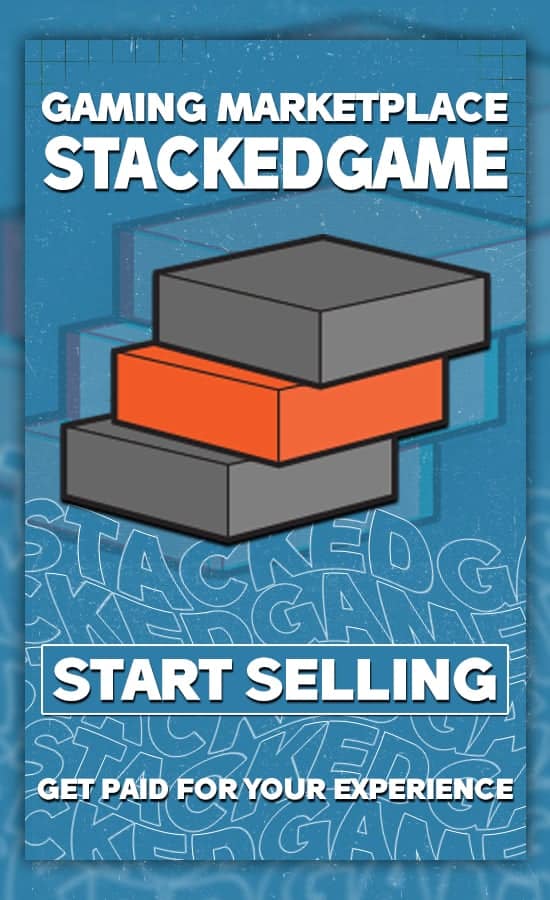Summary
How to Play Your First TFT Match
Teamfight Tactics (TFT) is a recently introduced game, belonging to a genre that’s still in its infancy, having emerged less than a year ago. Amidst all the excitement surrounding it, it might feel like you’re lagging behind the crowd. However, in the grand scheme of things, starting your journey now actually places you among the early adopters in its lifespan.
Embarking on a new game, especially one from a fresh genre, can feel daunting at times. There’s a wealth of information to absorb, but that’s all part of the thrill! In this guide tailored for absolute beginners, we aim to provide you with the fundamentals so that you can confidently navigate through your inaugural TFT match.
Assuming you possess a basic understanding of TFT and are eager to dive into your first game, this guide is perfect for you. And even if you’ve already dipped your toes into the TFT waters and desire to deepen your knowledge, rest assured, there’s always something new to discover.
How do you win in Teamfight Tactics?
The primary objective in TFT is to outlast your opponents in an 8-player free-for-all match. Throughout the game, you’ll amass resources such as gold and items while strategically assembling a team of units with diverse strengths, weaknesses, and abilities.
By creating a team with units that synergize well together, you enhance their effectiveness with boosted properties. These units will engage in battles against other players’ teams randomly during rounds. The player whose team is defeated will incur damage, and upon running out of life, they’re eliminated. However, achieving a top 3 placement is considered a victory, so aim for that even if winning seems challenging.
The Carousel
Each game commences with all 8 players gathering at the carousel, also referred to as the “shared draft.”
The carousel continuously rotates and presents random 1-cost units paired with basic items (more on items later).
After a brief delay, all eight players simultaneously select a unit. Simply approach and touch the desired unit with your Little Legend, and it will be yours.
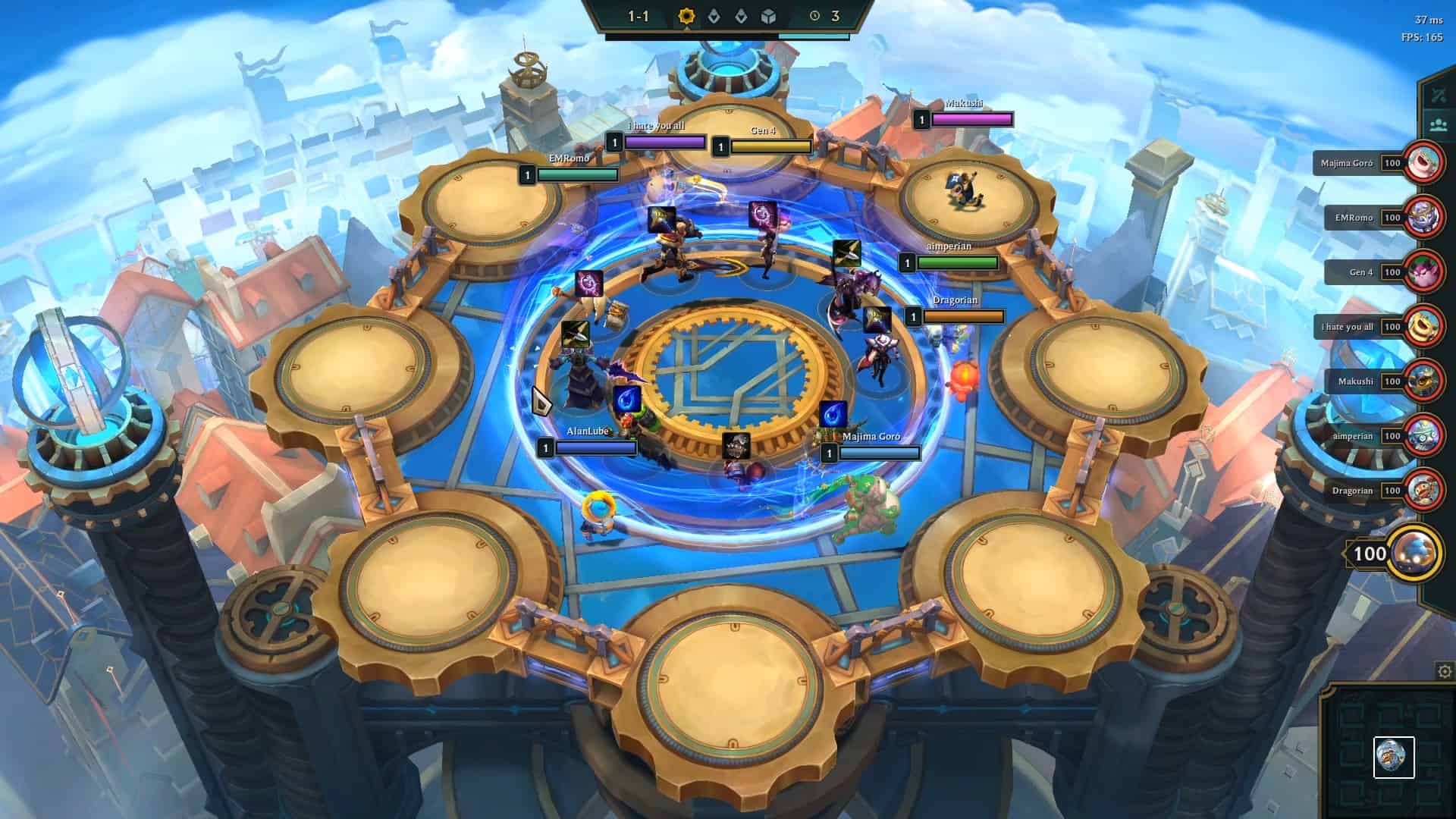
With experience, you’ll develop a better understanding of which champions or items offer more advantages, allowing you to strategize effectively. However, don’t fret too much about this initially.
Carousel rounds occur periodically throughout the match. Following the initial round, players choose units in an ordered arrangement from last place to first place.
Building your First Units: The Three Minion Rounds
Round 1: Placing your unit
Now that you have acquired your first piece and item from the carousel, it’s time for your first battle! Don’t worry too much, as the initial three rounds pit you against bot-controlled minions that are quite easy to defeat.
To learn more about your unit, you can right-click on them during battles or while they’re on your bench. This provides information on their synergies, health/mana, cost, rank, ability details (by hovering), and items (which can also be hovered over). Keep these details in mind, as we’ll discuss them further later on.
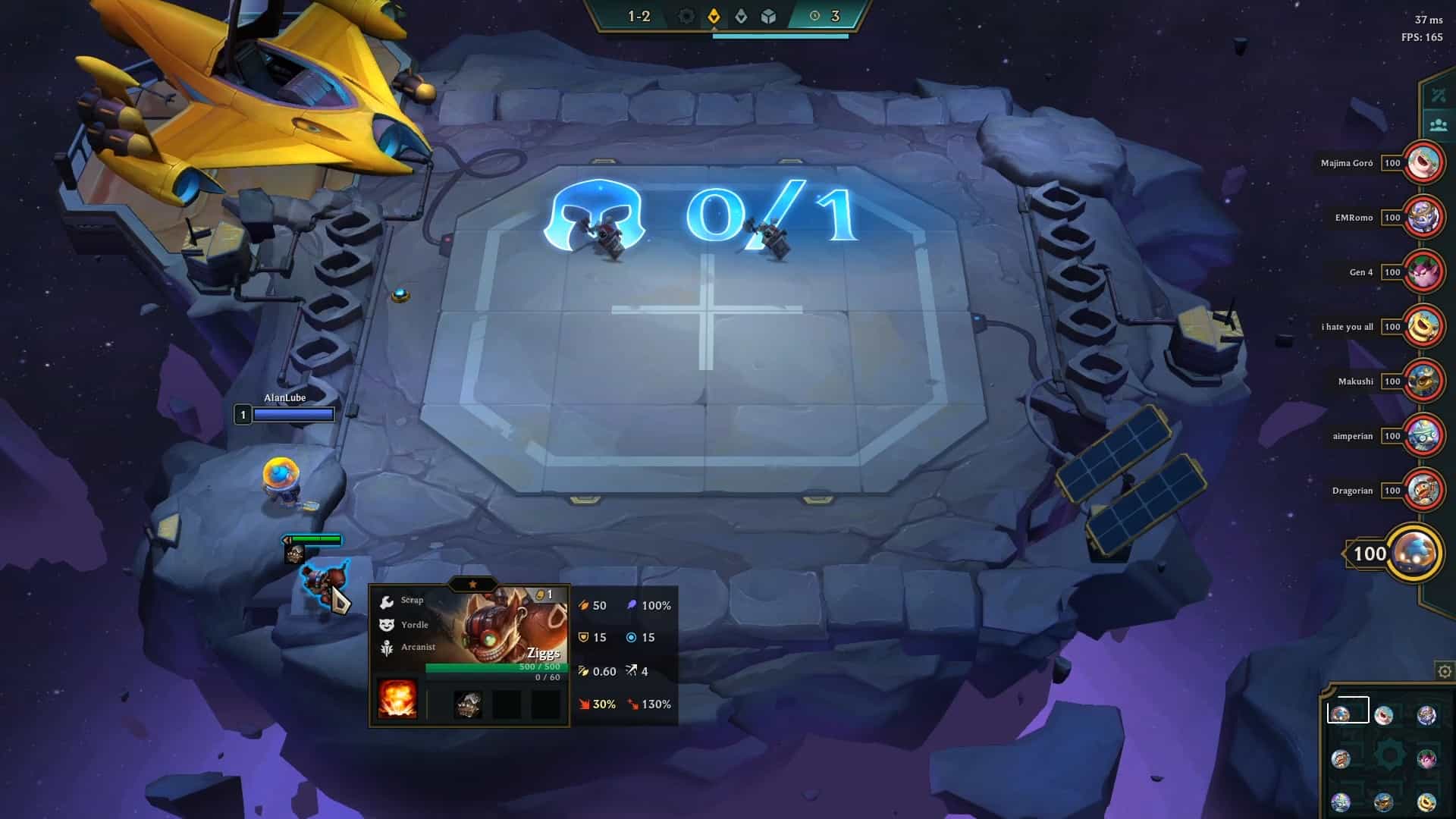
Right-click on any champion unit for more information about them.
To understand the sequence of events in each round, observe the icons at the top of your screen, indicating the carousel round, two minion fight icons, and a cube icon. These events unfold from left to right.
Before each battle, you’ll have a set time to prepare (as indicated by the countdown). Currently, you can only adjust the position of your unit, but you’ll have more options soon. For now, simply drag your first unit from your bench onto the board. (If you don’t do this, it will be automatically done for you)
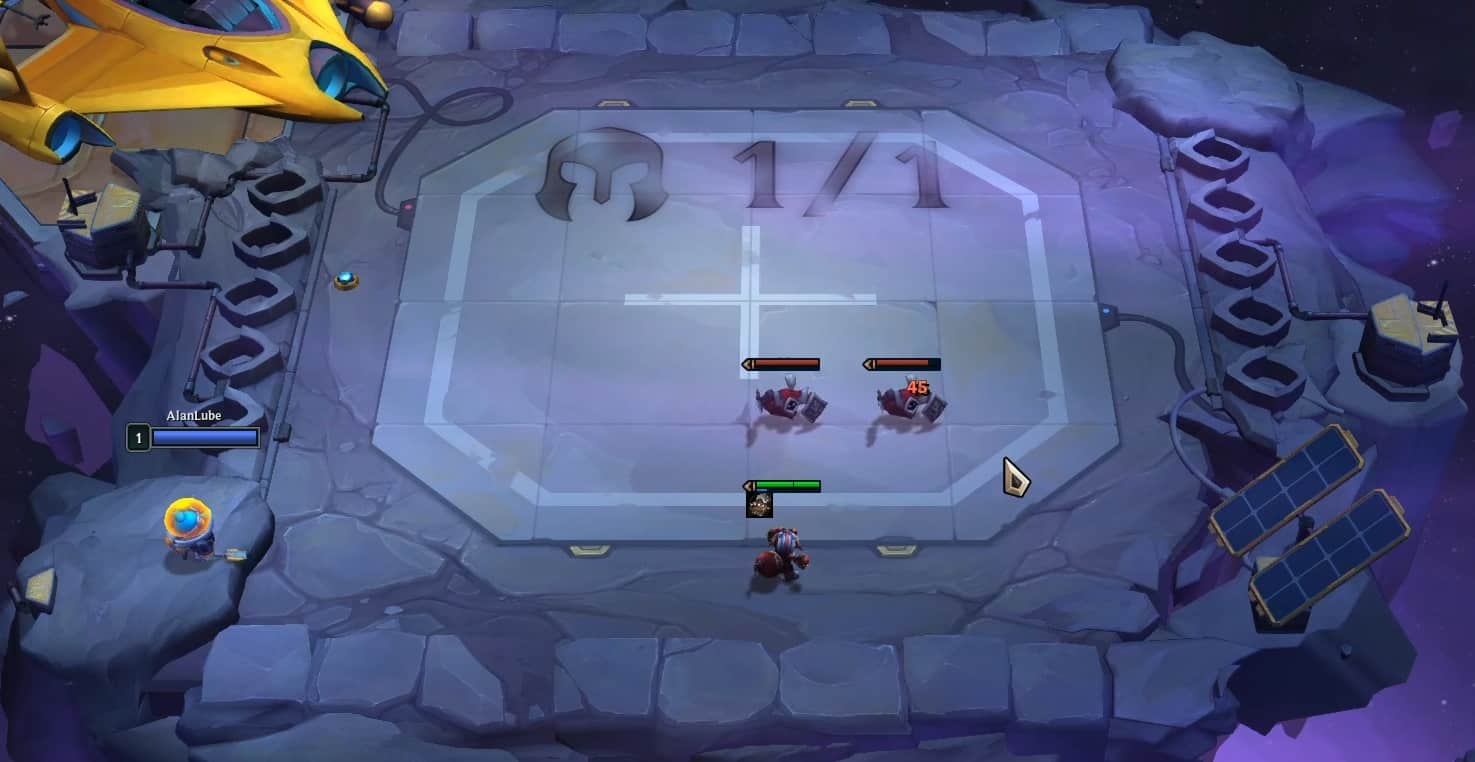
In this game, we grabbed a Ziggs with a Sparring Gloves
Once the countdown ticks down, the action kicks off, and your unit springs to life to take on the minion bots. Since these minions are weak, your lone unit should have no trouble dispatching them with ease.
Mana and Abilities Keep an eye on your unit’s blue mana bar as they engage in combat. It gradually fills up as they deal and receive damage. Once the bar is full, your champion will unleash their ability. For instance, Ziggs’ ability, the Mini Inferno Bomb, deals damage to enemies in a radius.

It’s worth noting that not every champion has a casted ability. For champions like Warwick, their abilities are passive, so no casting occurs.
Item Drops Defeating bot-controlled minions and monsters presents an opportunity to receive item drops. These drops occur outside of the carousel rounds, making these battles crucial for item acquisition.
For example, in the image, we obtained an additional Sparring Gloves by defeating the minions. Since these minion rounds are relatively easy, there’s no rush to combine items. Instead, you can keep them on the bench to keep your options open.
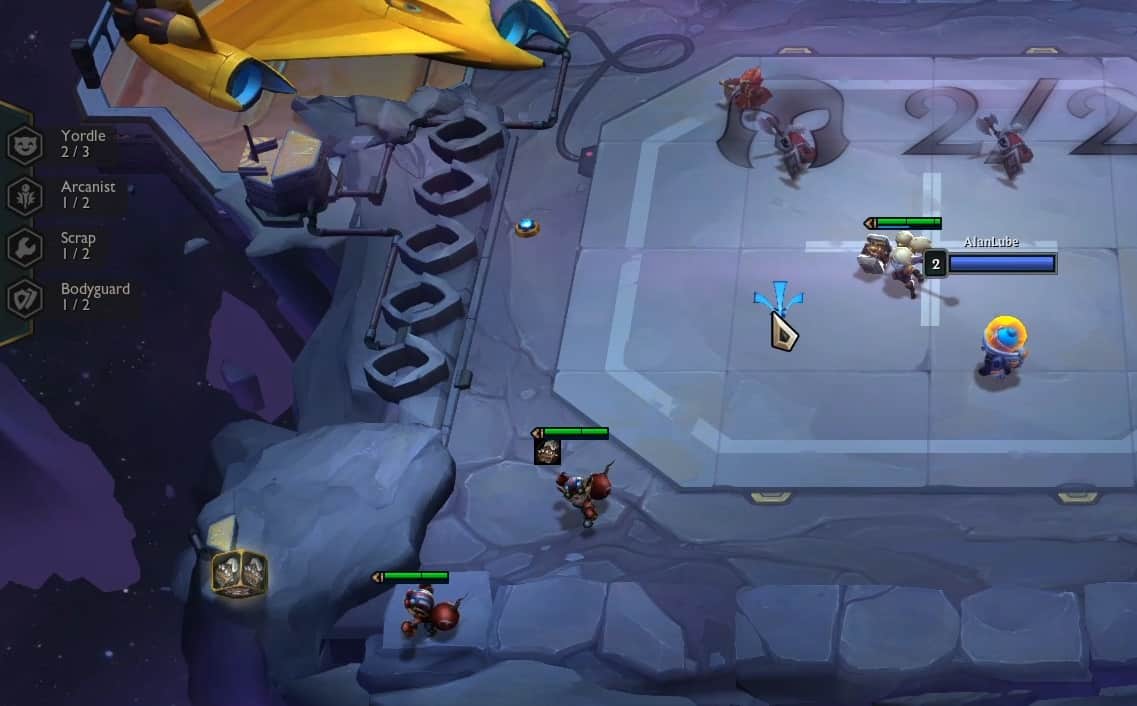
Hextech Augments
In Set 6, keep an eye out for the Cube image at the top, indicating a time to choose a Hextech Augment. This exclusive mechanic grants your team bonuses based on the chosen Augment. These opportunities arise three times throughout the game, occurring at rounds 1-4, 3-3, and 4-5.
Rounds 2 and 3: The Shop After the initial minion round, the game begins to unfold, offering you opportunities to make strategic decisions and craft your team composition. Here’s a breakdown:
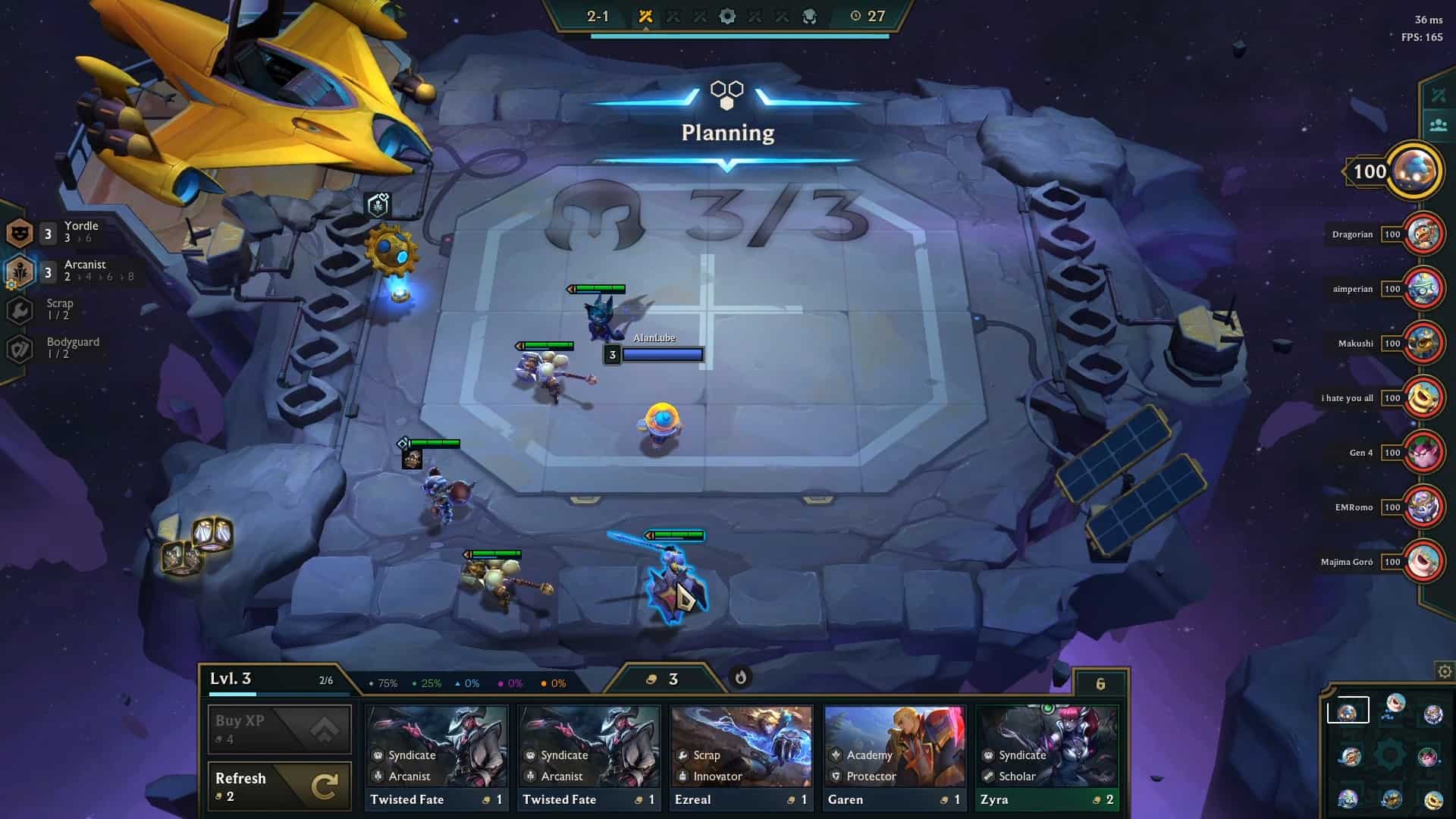
At the start of round 2 and subsequent rounds until the game concludes, you’ll be presented with five champion units to choose from at the shop. All eight players draw from a shared pool of finite pieces.
Each unit’s cost, synergies, and ability description are visible when hovered over.
Above the five units, your available gold is displayed. In addition to purchasing units, you can use gold to refresh or “reroll” for another set of five champions for 2g or buy 4 experience points for 4g. Selling units on your board or bench is also an option, although you may not always receive equal value.
You can opt to lock your shop to prevent it from refreshing at the start of the next round by clicking on the top right corner.
Refresh: Rerolling may present the same champions as in previous rolls. Rolling odds will be discussed later. Buy XP: Your player level determines the maximum number of pieces you can have on the board. You passively gain experience each round, but spending gold allows you to increase your level and the maximum number of units (up to 9 using experience). The points required to reach your next level and your current level are displayed on the left side of the shop. Lock: If you’re satisfied with the current options but lack enough gold to purchase everything, consider locking your shop to buy later with more gold. Sell: Units can be sold by dragging them onto the shop or by clicking them and pressing E.
With numerous options available, understanding when and why to buy champions can be challenging initially. As a beginner, focus on building towards your unit synergies.
Building Unit Synergies
Constructing a team around synergies lies at the heart of auto chess games like Teamfight Tactics. Synergies come in two types: class and origin, with each champion possessing at least one of each (some may have more).
Recall when we right-clicked on Ziggs earlier for details? We discovered that he belonged to the Yordle origin and the Arcanist class. As we’ve acquired different champions since then, the highlighted synergies now reflect the traits present on our board. These indicators show the current synergies activated by your units and the number of units needed to activate a synergy’s ability.

You’ll also notice synergy information when browsing units in the shop. Removing units from the board will cause the corresponding synergies to disappear from the left side of the screen.
For instance, Ziggs’ origin is Yordle. If we manage to acquire more Yordle units (note: additional Ziggs won’t count), such as Vex and Poppy, the Yordle trait will activate.

Ziggs also belongs to the Arcanist class, presenting another strategic avenue with its own advantages and drawbacks.

Teamfight Tactics features a plethora of intriguing synergies. To delve deeper into their unique abilities, be sure to explore our wiki pages dedicated to origins and classes.
The approach to learning about team compositions varies from player to player. If you prefer a hands-on approach, feel free to experiment and discover synergies through trial and error.
However, if you’re eager for immediate success or seeking expert guidance on effective compositions, check out our team composition recommendation guides. These resources offer refined and tested builds crafted by high-level players.
Ranking Up Units/
Ranking Up Units Another fundamental mechanic in TFT is ranking up, achieved by combining identical units to create stronger ones.
You can rank up your units by combining three copies for each tier:
- Three 1-star units merge into one 2-star unit.
- Three 2-star units merge into one 3-star unit.
This means you’ll need a total of nine 1-star units to create a 3-star unit.
Units purchased from the shop start as 1-star units unless they are Chosen (a Set 4 mechanic).
In the image below, we can observe two 1-star Ziggs units on the bench and on the board, along with one Ziggs available in the shop.
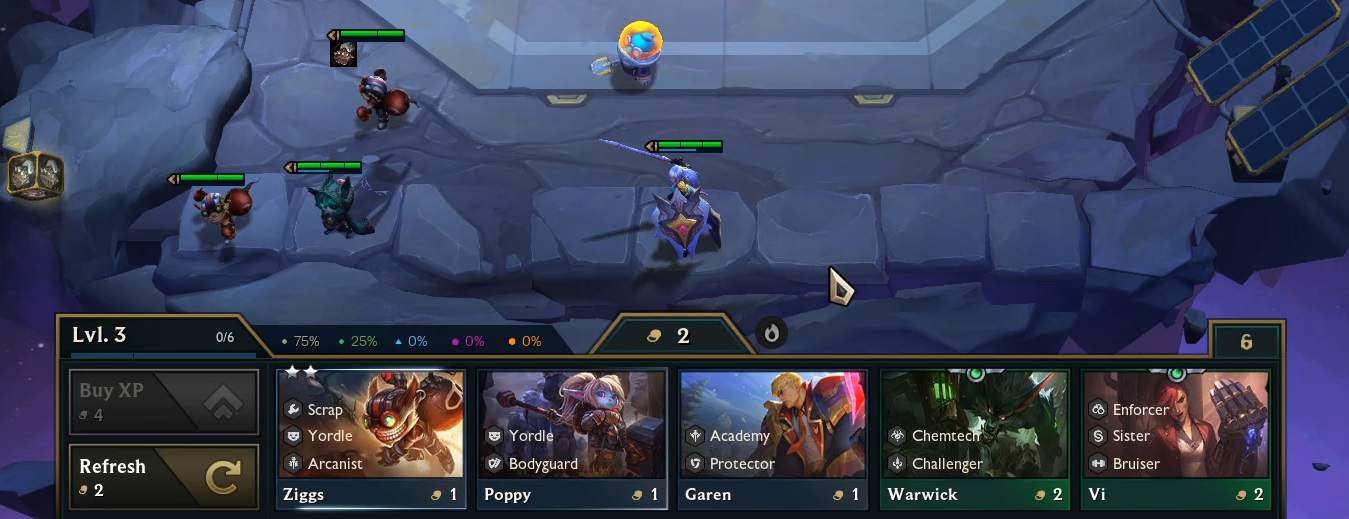
Upon purchasing the Ziggs from the shop, all three Ziggs units will automatically combine into a 2-star Ziggs. This transformation not only increases Ziggs’ size but also enhances his power. Additionally, the rank-up will be announced in the chat log, drawing attention from other players, so be mindful of their activity.

In the image above, we notice that Ziggs now displays a silver icon to the left of his health bar, replacing the bronze one. Upon right-clicking to inspect him, we can observe two stars instead of one.
Hovering over an ability reveals how it scales with increasing rank, indicating its growing strength. With Ziggs now at 2 stars, his ability will deal 425 damage instead of 325.
In addition to assembling team synergy, continuously upgrading your units throughout the game is crucial. By the game’s conclusion (if you survive until then), most of your team should ideally be 2 stars, with a few even reaching 3 stars if you strategize effectively.
As you progress in levels, the pool of champions available to you and their likelihood of appearing changes (details provided in the table below). To simplify, if you’re aiming for a 3-star unit, it’s advisable to delay leveling up, as doing so may reduce the chances of it appearing
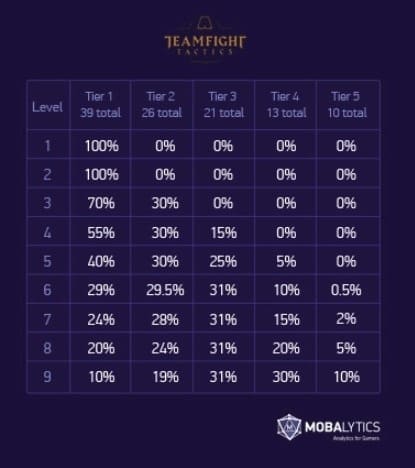
Likewise, if you’re looking to find a higher cost unit to complete the last part of your synergy, you may want to buy experience to increase your chances of it appearing. Just like a game of poker or a card game like Magic the Gathering, it’s all about playing the odds and doing what you can to understand and influence them.
Now that we know the basics of team building and which units to target, let’s get back to the game walkthrough.
Round 2-1 and Onwards: PvP Until Last Player Standing
Following the conclusion of the three minion rounds, Round 2-1 initiates, marking the beginning of player vs. player battles. As depicted in the image below, we engage in three PvP battles before a carousel round, followed by two more PvP battles, and finally, a creep round.
This pattern repeats until one player remains standing (top 4 counts as a win). In the subsequent sections, we’ll explore the overarching concepts of a match rather than providing a detailed breakdown of each round.

PvP Rounds
During the PvP rounds, you’ll confront a random opponent and pit your team of champions against theirs.
The amount of damage inflicted on the losing side depends on the outcome of the battle. Although there’s a specific formula for this, for simplicity’s sake in this beginner’s guide, think of it in terms of the number of units that survive on the winning side.
A closely contested battle resulting in a 1v1 between the final units inflicts a small amount of damage on the losing side. Conversely, if the winning side emerges victorious with numerous surviving units, the loser sustains a substantial amount of damage.
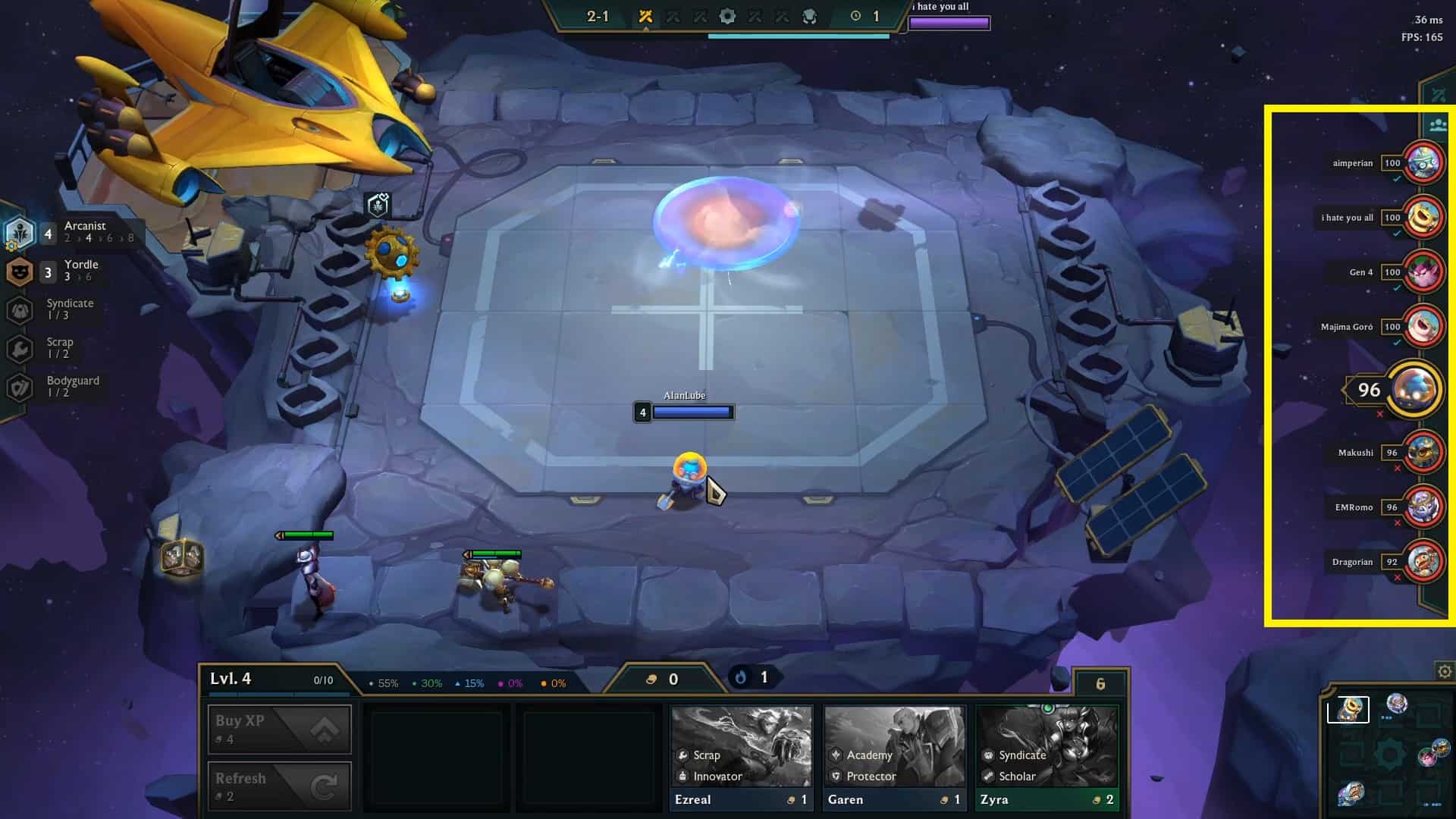
In the image above, in yellow, you can see the standings based on how much health players have. By clicking on their icon, you can also take a look at their board and bench.
You can also do this by clicking on the minimap at the bottom right, or by using the 1, 2, and 3 keys to rotate between player boards or return to your own (1 and 3 cycle, 2 returns you back home).
Carousel
As we mentioned earlier during the carousel section, player standings can be important because it determines the order in which players choose their pieces at the next carousel phase.

All players begin the carousel phase locked and are released in reverse order starting with last place and ending with first place. This lets players who have fallen behind an opportunity to catch up since they are more likely to get the item and unit that they need most.
At this point, you may be asking, if players that are doing worse get better choices at carousel rounds, what’s the point of being ahead? Well, I’m glad you asked.
The Basics of Econ: Win Streaks, Lose Streaks, and Interest
In Teamfight Tactics, you’ll get passive income for free each round. The first few rounds, you’ll gain increasing gold every round starting from 2 gold up until a base of 5 gold per round. You get 2g round 2, 3g round 3, 4g round 4, and 5g round 5 and every round after.
You also get additional gold based on win/loss streaks and interest. If you are winning or losing consecutively, you will gain extra gold – here’s how it works:
- 2-3 round streak = 1 extra gold per round
- 4 round streak = 2 extra gold per round
- 5+ round streak = 3 extra gold per round
This rewards players who have been doing well and throws some love to players who are having a rough time (there’s actually an advanced playstyle where you lose on purpose to get lose streak income and a good place in line for carousels, but that’s not for this article). You also get +1 gold for rounds that you win.
Depending on how much gold you have at the end of a round, you also get an interest bonus at the beginning of your next round. The amount of interest you get is related to every 10 gold you have up until 50:
- 10g = +1g interest
- 20g = +2g interest
- 30g = +3g interest
- 40g = +4g interest
- 50g = +5g interest (the max)
- Example: If you end the round with 34g, you will have an additional +3g from interest next round.
You can check how much gold you’re earning per round at any time by hovering your gold in shop (shown in red below). You can also get an idea of how much gold another player has by looking at the counters on the sides of the board (shown in yellow below).
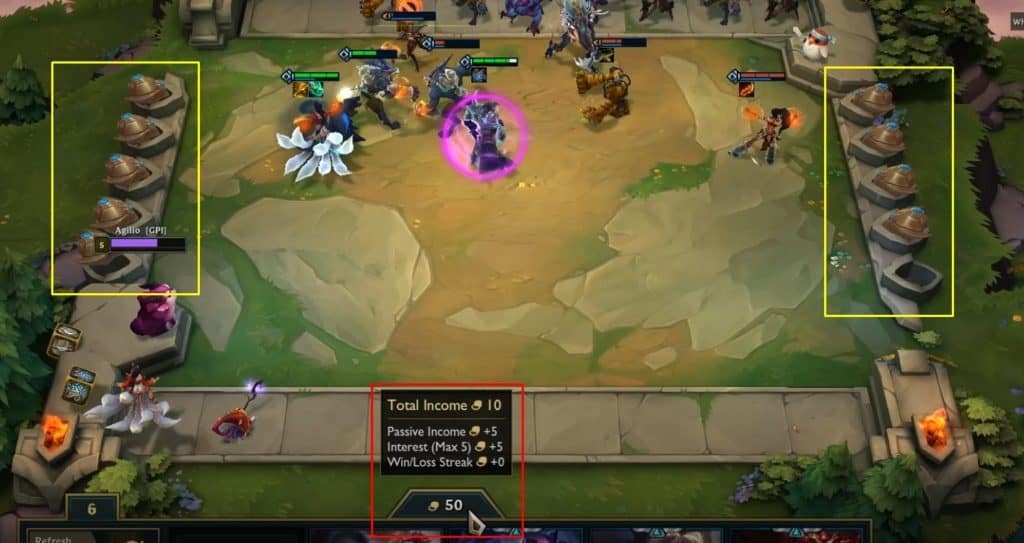
Red: hover your gold in show to see your total income. Yellow: see how much interest each player is getting.
Each counter represents how much interest a player is receiving. The counters on the left represent your interest – since we have 50g in the bank, that means we’d get 5g in interest, hence the 5 counters. In a similar fashion, the opposing player has at least 40g, as shown by the four counters on the right. Unfortunately, you can’t tell the exact amount of gold your opponents have but at least this gives you a good idea.
To learn more, we strongly recommend checking out our TFT economy guide. We’ll cover these topics in more depth and give fundamental strategies regarding gold and econ management.
Positioning Basics
In the image above, highlighted in yellow, you can view the standings based on players’ remaining health. Clicking on their icon allows you to inspect their board and bench.
You can also accomplish this by clicking on the minimap at the bottom right or by using the 1, 2, and 3 keys to cycle between player boards or return to your own (1 and 3 cycle, while 2 brings you back home).
Carousel
As previously mentioned during the carousel section, player standings are significant as they determine the order in which players select their pieces in the next carousel phase.
All players start the carousel phase locked and are released in reverse order, beginning with the last-place player and concluding with the first-place player. This gives players falling behind an opportunity to catch up, as they are more likely to acquire the item and unit they need most.
Now, you might wonder, if players performing poorly get better choices during carousel rounds, what’s the benefit of being ahead? Well, let’s delve into the basics of Econ: Win Streaks, Lose Streaks, and Interest.
In Teamfight Tactics, you receive passive income for free each round. Initially, you’ll earn increasing gold every round, starting from 2 gold up to a base of 5 gold per round. This progression includes 2 gold in round 2, 3 gold in round 3, 4 gold in round 4, and 5 gold in round 5 and beyond.
Additionally, you earn extra gold based on win/loss streaks and interest. Consecutive wins or losses grant additional gold as follows:
- 2-3 round streak = 1 extra gold per round
- 4 round streak = 2 extra gold per round
- 5+ round streak = 3 extra gold per round
This system rewards successful players and provides support to those facing challenges. Furthermore, winning a round adds +1 gold to your income.
At the end of a round, depending on your total gold, you also receive an interest bonus at the beginning of the next round. The interest amount correlates with every 10 gold you possess, up to 50:
- 10g = +1g interest
- 20g = +2g interest
- 30g = +3g interest
- 40g = +4g interest
- 50g = +5g interest (maximum)
For instance, if you conclude a round with 34g, you’ll receive an additional +3g from interest the following round.
You can monitor your income by hovering over your gold in the shop (shown in red). Similarly, you can estimate opponents’ gold by observing the counters on the board’s sides (displayed in yellow).
Each counter indicates the interest a player receives. The left counters represent your interest, indicating 5 counters for 50g in the bank. Similarly, the opposing player likely has at least 40g, evident from the four counters on the right. Although you can’t determine opponents’ exact gold, this offers a good estimate.
For further insights, we recommend exploring our TFT economy guide, which delves deeper into these topics and provides essential strategies for gold and econ management.
Positioning Basics
Effectively positioning your units is crucial, as it can significantly impact their performance in battle and the outcome of the match.
Here are some general guidelines:
- Place units where they can generate mana by dealing and taking damage to cast their abilities efficiently.
- Ensure your units cast their ability at least once during the battle. If they perish before doing so, adjustments may be necessary.
- Typically, team compositions resemble those in League, featuring a sturdy frontline to protect squishy backline damage dealers and utility units.
- As the game progresses and you gain insight into your opponents’ compositions, adjust your positioning accordingly.
- To streamline unit swapping, drag one unit onto another. They will automatically exchange positions, whether on the board or bench.
To provide better context, let’s discuss the primary fundamental of positioning: Frontline and Backline.
Frontline and Backline

At the most fundamental level, positioning your units revolves around a simple concept: frontline and backline.
Frontline Units: Frontline units typically possess defensive traits like Bruiser or Bodyguard, enabling them to absorb damage from enemy teams. These units are often melee, so positioning them at the front ensures they engage enemies without delay.
Backline Units: Conversely, backline units fulfill the opposite role. These units usually specialize in dealing damage, such as Caitlyn, or providing utility abilities like healing and shields. With ranged capabilities, they can target enemy frontline units without requiring significant movement.
While adhering to this basic framework, you can explore additional nuances, such as positioning units towards the sides or center of the board. Certain synergies may also influence whether you cluster units closely together or space them apart.
For deeper insights into unit placement and fundamental positioning concepts, refer to our TFT positioning guide.
How to Combine Items and Assign Them
Throughout this guide, we’ve mentioned obtaining items from carousels or monster rounds without delving into their purpose and utilization. Here’s what you need to know about maximizing item effectiveness and prioritizing their distribution:
- Each unit can hold a maximum of three items.
- Item assignments are permanent; to transfer an item to another unit, you must sell the current holder.
- Items come in two types: basic and combined. Combining two basic items yields a combined item.
- Generally, you’ll use items to enhance your team composition’s strengths.
Items offer a range of benefits, from basic stat boosts like health and attack speed to game-changing effects that surpass unit limitations. Strategically assigning items to the appropriate units significantly enhances your chances of victory, particularly against opponents who underutilize their items.
Example #1: Guinsoo’s Rageblade on Tristana (empowering auto-attackers)

Needlessly Large Rod + Recurve Bow = Guinsoo’s Rageblade
Combining a Needlessly Large Rod with a Recurve Bow creates Guinsoo’s Rageblade. This item bestows its wearer with a 6% additional attack speed boost every time they attack, and these bonuses can stack infinitely. Consequently, the wearer’s attack speed accelerates continuously throughout a battle, making them more formidable as the confrontation progresses.
Example#2: Spear of Shojin on Viktor (cast abilities more often)

BF Sword + Tear of the Goddess = Spear of Shojin
If it wasn’t clear before, abilities play a crucial role in TFT gameplay. As highlighted in the positioning segment, successfully unleashing an ultimate ability is often considered a significant achievement. Spear of Shojin significantly impacts gameplay by allowing its wielder to cast their ability more frequently, as they gain 8 mana per attack.
This effect is particularly potent on champions with powerful ultimates, such as Viktor, whose ability deals significant damage to multiple enemies with lasers. With Shojin, Viktor has the potential to cast his ability multiple times in a single fight, provided he survives long enough to do so.
Navigating the realm of items in TFT can be challenging for beginners. As you embark on your TFT journey, experimenting with various items is a wise approach to familiarize yourself with their functionalities and effectiveness.



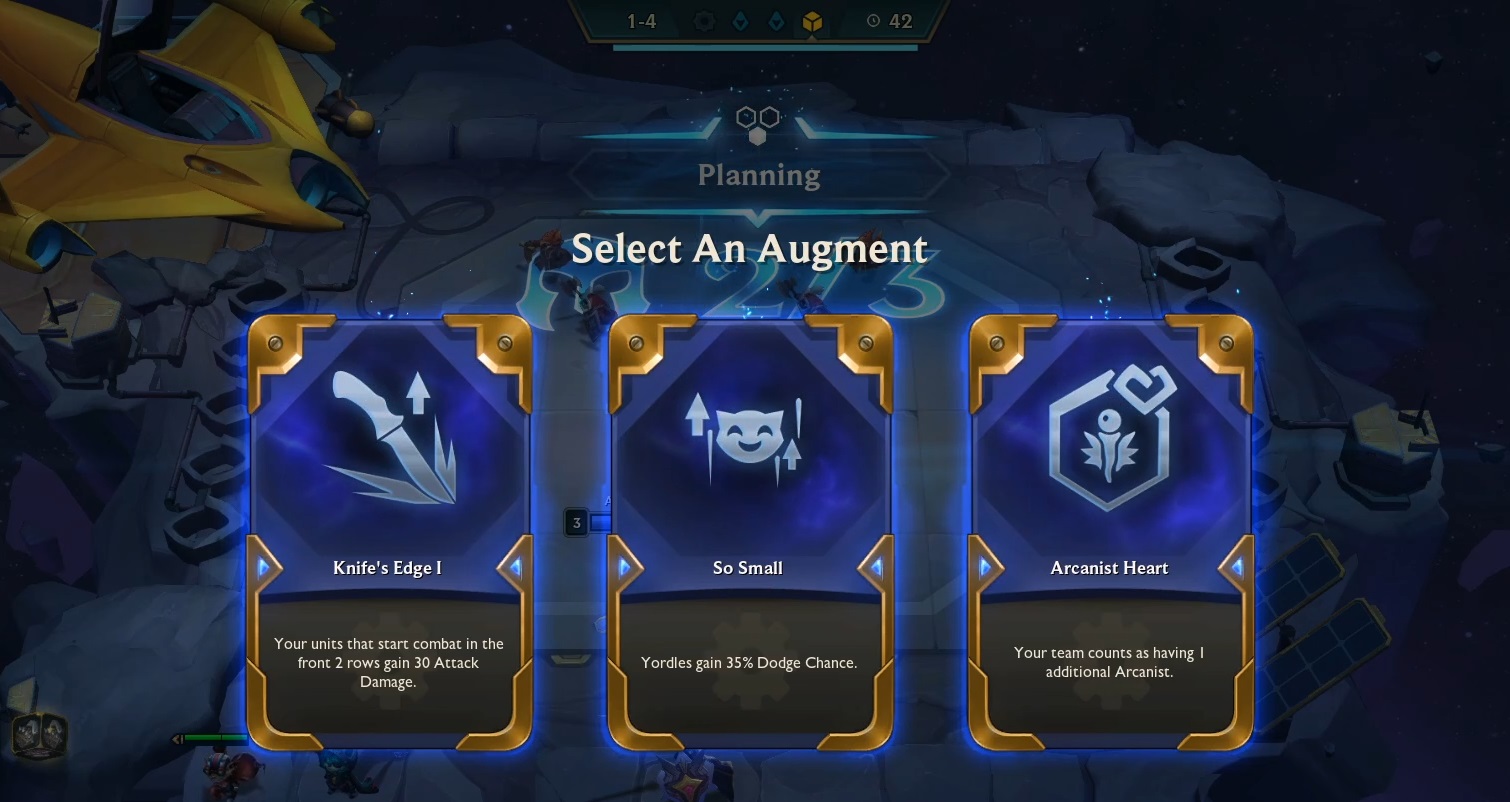




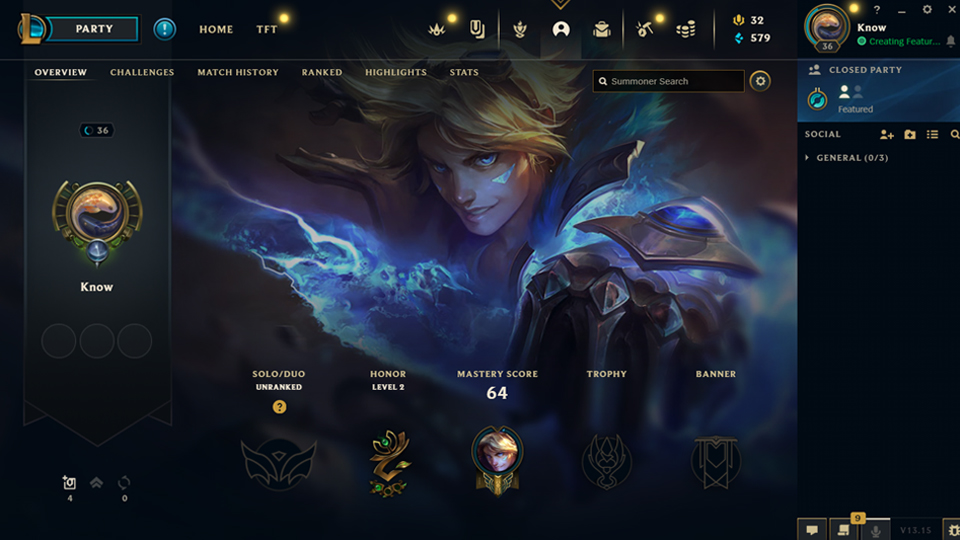
![WoW: Slashdance – Digital Code [Instant]](https://cdn3.stackedgame.com/sell/wowloot/I_42495/slashdancejpg.jpg)
![[PS4] Fortnite Pack: Anime Legends DIGITAL](https://cdn3.stackedgame.com/sell/fortnitenow/I_42453/ps4animelegendsjpg.jpg)
![[XBOX] Fortnite Pack: Anime Legends DIGITAL](https://cdn3.stackedgame.com/sell/fortnitenow/I_42450/xboxanimelegendsjpg.jpg)
![Fortnite Code: Rebirth Harley Quinn [Key]](https://cdn3.stackedgame.com/sell/fnbrcodes/I_42423/harleyquinnrebirthjpg.jpg)
